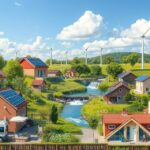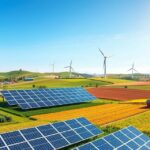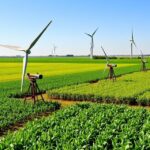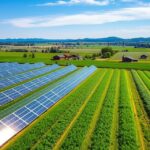Just 1 foot of water drop can generate electricity for multiple small devices. DIY hydroelectric generators are changing how we view renewable water energy for home power.
Small-scale water power systems turn ordinary water flow into clean electricity. This approach lets homeowners use natural water resources to power smartphones and laptops.
DIY hydroelectric generators open new doors in personal energy production. With basic skills and equipment, you can create a compact power system.
This system cuts electricity costs and reduces dependence on traditional power grids. It’s a practical solution for off-grid living and emergency preparedness.
Learning to convert water movement into electrical energy is a big step toward energy independence. This guide covers creating your own hydroelectric generator from start to finish.
We’ll help you choose the right water source and assemble key components. If you have a stream, river, or consistent water flow, you can generate your own electricity.

Introduction to DIY Hydroelectric Generators
Renewable energy is crucial for sustainable power generation. Hydroelectric power is an innovative approach to clean energy. It’s perfect for DIY enthusiasts interested in homemade water turbine projects.
Sustainable energy projects offer exciting opportunities for individuals. A hydro power turbine can turn flowing water into electrical energy. This makes it an attractive option for alternative power sources.
Understanding Hydroelectric Power
Hydroelectric power uses moving water’s energy to generate electricity. The process involves three key steps:
- Converting water’s motion into mechanical energy
- Transforming mechanical energy into electrical power
- Using turbines to capture water’s natural movement
“Water is the driving force of all nature.” – Leonardo da Vinci
The Importance of Renewable Energy
Homemade water turbine systems offer many benefits:
| Benefit | Impact |
|---|---|
| Environmental Protection | Reduces carbon emissions |
| Energy Independence | Decreases reliance on fossil fuels |
| Cost Efficiency | Lowers long-term energy expenses |
Learning about hydro power turbines can help you create sustainable energy solutions. You can take big steps towards generating your own clean electricity.
Benefits of Small-Scale Water Power
Micro hydroelectric generators offer a fresh take on home energy production. These systems provide a sustainable alternative to traditional power sources. Homeowners can now generate their own eco-friendly electricity.
Small-scale water power systems benefit eco-conscious homeowners. They provide green energy solutions that are both efficient and effective.
Cost-Effective Energy Production
A micro hydroelectric generator can slash long-term electricity costs. Homeowners enjoy savings through minimal operational expenses and reduced grid dependence. These systems also require little maintenance.
- Minimal operational costs
- Reduced reliance on grid electricity
- Low maintenance requirements
Environmentally Friendly Solution
Water energy is a clean alternative to fossil fuels. These systems generate power without producing greenhouse gas emissions. This supports efforts to protect our environment.
| Energy Source | Carbon Emissions | Sustainability Rating |
|---|---|---|
| Micro Hydroelectric | Near Zero | High |
| Coal Power | High | Low |
Energy Independence and Security
“Small-scale hydroelectric power empowers homeowners to take control of their energy production.” – Renewable Energy Expert
Micro hydroelectric generators offer unmatched energy independence. Homeowners can produce electricity right on their property. This reduces reliance on external power sources.
- Reduce vulnerability to power grid disruptions
- Create a reliable backup power source
- Decrease dependence on external energy providers
Home hydroelectric power is a smart choice for sustainable energy. It provides reliable, cost-effective, and eco-friendly electricity. Investing in this technology can lead to long-term benefits.
Components Needed for a DIY Hydro Generator
Building a DIY hydroelectric generator requires careful planning and the right components. Knowing the essential parts is crucial for your homemade water turbine project. This guide will help you select the best components for your needs.
Turbine Selection and Design
The right hydro power turbine is key to your DIY generator’s success. Different turbines work best for various water flow conditions. Choose wisely based on your specific water source.
- Pelton wheel – ideal for high-head, low-volume water sources
- Crossflow turbine – suitable for medium-head water flows
- Propeller turbine – best for low-head, high-volume streams
Essential Electrical Components
Your homemade water turbine needs specific electrical parts. These components convert water energy into usable electricity. Make sure to include all of them in your project.
- Permanent magnet generator
- Voltage regulator
- Battery storage system
- Inverter for AC conversion
Materials and Tools Required
Gathering the right materials ensures a reliable DIY hydroelectric generator. You’ll need these essential items to build your system:
- Waterproof bearings
- Durable blades (aluminum or stainless steel)
- Electrical wiring
- Mounting brackets
“The key to a successful DIY hydroelectric generator is selecting components that match your specific water resource characteristics.” – Renewable Energy Expert
Choose and combine these components carefully. This will help you create an efficient, small-scale hydroelectric power system. Your system will be tailored to meet your unique energy needs.
How to Select the Right Water Source
Choosing the best water source is key for a small-scale water power system. Your local water resources can generate electricity. Understanding their potential is crucial for renewable water energy.
Evaluate your water source’s features before setting up a DIY hydroelectric generator. The right spot can boost your renewable water energy output. This careful assessment is vital for success.
Evaluating Water Flow Availability
Water flow assessment involves several critical factors:
- Measure water velocity using a current meter
- Calculate average seasonal water volume
- Identify consistent water flow patterns
- Check for potential flow disruptions
Assessing Potential Energy Output
Calculating energy potential requires understanding two key measurements:
| Measurement | Description | Impact on Power Generation |
|---|---|---|
| Water Head | Vertical distance water falls | Higher head increases power potential |
| Flow Rate | Volume of water passing per second | Greater flow generates more electricity |
“Know your water source, and you’ll unlock the potential of small-scale water power.” – Renewable Energy Expert
Think about local environmental conditions when picking a water source. Seasonal changes and ecological impacts matter too. A thorough review ensures sustainable and efficient energy production.
Step-by-Step Guide to Building Your Hydro Generator
A DIY hydroelectric generator is a great sustainable energy project. It can power small devices using clean energy. This guide will help you build your own water turbine.

Understanding key components is crucial for this project. Proper preparation ensures success. Let’s explore the essential steps for your homemade generator.
Preparing the Installation Site
Choosing the right location is vital for your generator. Consider these important factors:
- Water flow consistency and volume
- Terrain gradient and accessibility
- Distance from electrical connection points
- Environmental protection and local regulations
Turbine Construction Techniques
Building a water turbine requires precision and planning. The design affects your generator’s efficiency. Choose the right type for your needs.
| Turbine Type | Efficiency | Best Used For |
|---|---|---|
| Pelton Wheel | High (80-90%) | High-head, low-volume water sources |
| Crossflow Turbine | Medium (70-80%) | Medium-head, moderate water flow |
| Propeller Turbine | Low-Medium (60-70%) | Low-head, high-volume water sources |
Electrical Component Assembly
The final stage involves connecting electrical components carefully. Follow these steps for proper assembly:
- Select an appropriate generator or alternator
- Install voltage regulation system
- Create secure electrical connections
- Set up battery storage (optional)
“The key to a successful DIY hydroelectric generator is patience, precision, and careful planning.” – Renewable Energy Expert
Follow these steps to create a reliable energy solution. Your DIY generator will turn water flow into usable electricity. It’s perfect for homes or off-grid setups.
Common Challenges in DIY Hydro Projects
Building a micro hydroelectric generator for home energy has unique challenges. Small-scale water power systems need careful planning and troubleshooting. Understanding potential obstacles helps create more effective home energy solutions.
Managing Water Flow Fluctuations
Water flow changes can impact your micro hydroelectric generator’s efficiency. Seasonal shifts, droughts, and stream variations create unpredictable energy generation. Strategic planning is crucial for successful small-scale water power projects.
- Install water flow measurement devices
- Create backup storage systems
- Design flexible turbine configurations
- Implement predictive monitoring techniques
“Consistent water management is key to sustainable hydroelectric power for home energy needs.” – Renewable Energy Experts
Issues with Electrical Connectivity
Electrical connectivity is a critical challenge in DIY hydroelectric generator installations. Waterproof connections, proper grounding, and voltage regulation are essential for safe power generation.
- Use marine-grade electrical components
- Implement waterproof junction boxes
- Install surge protection systems
- Regularly inspect electrical connections
Professional consultation can help mitigate potential electrical risks in your small-scale water power project.
Safety Considerations for Hydro Installation
DIY hydroelectric generators require careful safety measures. Water and electricity can be dangerous when combined. Proper planning is crucial for these sustainable energy projects.
Electrical Safety Precautions
Electrical safety is vital when working with water-powered electricity. Proper protection prevents accidents and ensures project success. Taking precautions is key to a safe installation process.
- Use ground fault circuit interrupters (GFCIs) for all electrical connections
- Install waterproof electrical enclosures
- Wear rubber-soled boots and insulated gloves
- Ensure all wiring meets national electrical code standards
“Safety is not an option but a necessity in DIY hydroelectric generator projects.” – Energy Safety Experts
Working Near Water: Best Practices
Water environments pose unique challenges for hydroelectric installations. Understanding potential risks helps create a safer workspace. Following best practices can prevent accidents.
- Conduct thorough site assessment before installation
- Check water flow stability and potential hazards
- Create safe working platforms away from slippery surfaces
- Maintain clear emergency exit routes
Always prioritize personal safety when developing water-powered electricity solutions. Professional guidance can reduce installation risks. It can also improve your project’s chances of success.
Maintenance Tips for Your Hydro Generator
Regular upkeep of your micro hydroelectric generator is vital for efficient energy production. It ensures optimal performance and reduces unexpected breakdowns. Proper care maximizes energy output from your homemade water turbine.
Effective maintenance of your DIY hydroelectric system involves key strategies. These methods can greatly extend your renewable energy setup’s lifespan.
Routine Inspections and Cleaning
Consistent care of your hydro power turbine requires a structured approach. Follow these steps for best results.
- Inspect water intake areas for debris and blockages monthly
- Check turbine blades for wear and potential damage
- Clean electrical connections to prevent corrosion
- Lubricate moving mechanical components quarterly
Troubleshooting Common Issues
Even well-maintained micro hydroelectric generators can face occasional problems. Knowing common challenges helps prevent long-term damage.
- Reduced power output: Often indicates sediment buildup or turbine misalignment
- Unusual noise: Could signal bearing wear or mechanical stress
- Electrical irregularities: Might suggest wiring or generator component issues
“Regular maintenance is the key to sustainable renewable energy production.” – Energy Experts Collective
Dedicated, systematic care ensures your homemade water turbine’s longevity. This approach helps provide reliable, clean energy for years to come.
Real-Life Applications of DIY Hydroelectric Generators
Renewable water energy has changed how homeowners approach eco-friendly power solutions. DIY hydroelectric generators offer new ways to use water for sustainable home energy.
These generators provide innovative methods to produce clean power. They’re perfect for those looking to reduce their carbon footprint.
Small-scale hydroelectric systems are gaining popularity among energy-conscious homeowners. These compact generators offer practical solutions for various living situations.
They’re especially useful for those seeking energy independence. Homeowners can harness water power to meet their electricity needs.
Off-Grid Living Solutions
Hydroelectric power benefits those living in remote areas. Rural homeowners near streams or small rivers can use this renewable energy source.
It provides consistent electricity without relying on the grid. This power source can reduce monthly energy costs significantly.
- Generate consistent electricity without grid dependence
- Reduce monthly energy costs
- Create a reliable power source in challenging terrain
“Water is the most promising renewable energy source for off-grid communities.” – Clean Energy Research Institute
Supplementing Home Energy Needs
DIY hydroelectric generators can supplement existing power sources. These eco-friendly solutions offer several advantages to homeowners.
- Reduced electricity bills
- Lower carbon footprint
- Enhanced energy resilience
Strategic placement of small hydro generators can provide consistent, clean energy for powering essential home systems and electronic devices.
Setting up a hydro system requires careful planning. However, the long-term benefits make it attractive for eco-conscious homeowners.
Renewable water energy offers a sustainable power solution. It’s an excellent choice for those looking to reduce their environmental impact.
Future of Renewable Water Energy in the US
Renewable water energy is evolving rapidly in the United States. Innovative technologies are transforming small-scale water power into a promising sustainable energy solution. New hydroelectric systems can generate electricity from minimal water flows, expanding possibilities across diverse regions.
Innovations in Hydroelectric Technology
Advanced micro-turbine designs are revolutionizing sustainable energy projects. These designs allow communities and homeowners to capture energy from smaller water sources. Companies like Natel Energy and Lucid Energy are creating compact hydroelectric generators for low-head water systems.
Policy and Support for Water Power Initiatives
Federal and state governments are recognizing small-scale water power’s potential. The Department of Energy provides research grants for innovative hydroelectric technologies. These support mechanisms drive the development of efficient, eco-friendly water-based energy generation techniques.
The future of renewable water energy is bright. Ongoing investments in research and supportive policies are crucial. Small-scale water power is set to become a key part of the US clean energy strategy.
FAQ
What is a DIY hydroelectric generator?
A DIY hydroelectric generator turns water flow into electricity using a homemade turbine and generator. It allows people to make power from moving water on their land. This small-scale system harnesses energy from streams, rivers, or other water sources.
How much electricity can a small-scale hydro generator produce?
The electricity output depends on water flow rate and head height. A small DIY hydroelectric generator can produce 100 to 1,000 watts. This is enough to power small appliances or charge batteries in off-grid situations.
What water sources are suitable for a DIY hydroelectric generator?
Ideal water sources include perennial streams, small rivers, and irrigation canals. They need consistent water volume and a minimum drop height of 3-4 feet. Water flow should have minimal seasonal variations for best results.
What are the primary components needed to build a hydro generator?
Essential components include a water turbine, generator, voltage regulator, batteries, and inverter. You’ll also need a pipeline, electrical wiring, mounting brackets, and shaft bearings. Protective housing for electrical components is important too.
Is a DIY hydroelectric generator environmentally friendly?
Yes, hydroelectric generators are very eco-friendly. They produce clean energy with minimal carbon emissions and low environmental impact. These systems can run non-stop without using fuel or creating waste.
How much does it cost to build a DIY hydroelectric generator?
The cost varies based on complexity and scale, ranging from $500 to $5,000. Basic systems can be built for around $1,000. More advanced setups with higher power output might need greater investment.
What maintenance is required for a DIY hydro generator?
Regular maintenance includes cleaning the turbine and checking electrical connections. You should also inspect water intake systems and lubricate moving parts. Seasonal checks help ensure optimal efficiency and prevent potential damage.
Are permits required to install a hydroelectric generator?
Permit requirements vary by location. Most areas need water rights permits and electrical installation approvals. Check local rules with municipal authorities and state agencies before starting your project.
Can a DIY hydroelectric generator work year-round?
Performance depends on consistent water flow. In areas with stable water sources, generators can run year-round. Seasonal changes might affect power generation. It’s wise to have backup energy sources for reliable power.
What safety precautions are necessary when building a hydro generator?
Critical safety measures include proper electrical grounding and waterproof components. Secure mounting and protective equipment are also important. Follow electrical codes and consider getting professional help for complex setups.






